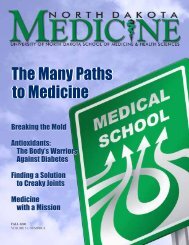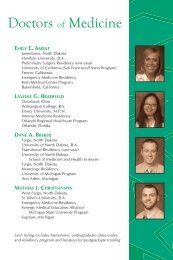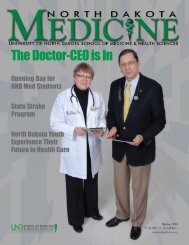View PDF - North Dakota Medicine
View PDF - North Dakota Medicine
View PDF - North Dakota Medicine
- No tags were found...
Create successful ePaper yourself
Turn your PDF publications into a flip-book with our unique Google optimized e-Paper software.
GUEST AUTHOR<br />
Life Expectancy and<br />
By Raymond L. Goldsteen, DrPH<br />
Director, <strong>North</strong> <strong>Dakota</strong> Master of<br />
Public Health Program at UND<br />
In October, the New York Times and other<br />
news media reported a deeply disturbing<br />
story: life expectancy among white men<br />
and women in the United States with less<br />
than a high school education has declined<br />
steadily and precipitously since 1990. For<br />
white women with less than a high school<br />
education, life expectancy dropped from<br />
over 78 years in 1990, to about 75 years in<br />
2000, and just over 73 years by 2008.<br />
Why is this story so disturbing Life<br />
expectancy has been increasing in the<br />
United States for all<br />
groups for over 100 years.<br />
Each generation has come<br />
to expect that it will live<br />
longer than the previous.<br />
During the 50-year period<br />
between 1900 and 1950,<br />
the Centers for Disease<br />
Control and Prevention<br />
documents a striking<br />
improvement in life<br />
expectancy in the United<br />
States. A person born in<br />
1900 could be expected to<br />
live, on average, 47.3<br />
years. By 1950, life<br />
expectancy was 68.2 years,<br />
a 44% increase over 1900.<br />
This improvement in life<br />
span had not been exceeded in the United<br />
States in any previous period. In the latter<br />
half of the twentieth century, longevity<br />
continued to increase for all groups. The<br />
decline found among people with low<br />
education starting in 1990 reversed this<br />
historical trend.<br />
Because life expectancy had been<br />
continually increasing in the United States<br />
among all groups for over 100 years, we<br />
have tended to forget that improvement is<br />
not inevitable. Life expectancy is a measure<br />
of the health of a population, not an<br />
individual’s health. For individuals, life<br />
expectancy is a probability, not a certainty.<br />
An individual within a population may live<br />
longer than expected or die before the<br />
“Because life expectancy<br />
had been continually<br />
increasing in the<br />
United States among<br />
all groups for<br />
over 100 years,<br />
we have tended to forget<br />
that improvement<br />
is not inevitable.<br />
expected age, but the average (or expected)<br />
age indicates the common situation<br />
affecting that population’s health.<br />
The story in the Times reminds us that<br />
life expectancy, that is, expected longevity<br />
for a group of people, results from<br />
conditions that affect the entire group, and<br />
if these conditions change for the worse,<br />
life expectancy will change for the worse as<br />
well. In the 1950s when we believed that<br />
antibiotics had eliminated microbial<br />
disease threats, René Dubos, the Pulitzer<br />
Prize–winning<br />
microbiologist, warned that<br />
new microbial diseases<br />
would always arise. In the<br />
1980s, Dubos was proved<br />
correct by the AIDS<br />
epidemic and others like<br />
H1N1 that followed. Today,<br />
the finding that life<br />
expectancy has declined for<br />
whites with low education<br />
sounds a similar warning.<br />
The improvement in life<br />
span during the first half of<br />
the twentieth century was<br />
”<br />
due in large part to control of<br />
infectious diseases. By midcentury,<br />
people were dying<br />
later in life and from<br />
different causes than their parents and<br />
grandparents. In 1900, infectious<br />
diseases—pneumonia and influenza,<br />
tuberculosis, and intestinal infections—<br />
were the three leading causes of death in<br />
the United States. These “Big Three”<br />
accounted for over 31 percent of all deaths.<br />
Other infectious diseases, including<br />
typhoid, diphtheria, and cholera, were<br />
major causes of death, as well. By 1950, the<br />
“Big Three” had become heart disease,<br />
cancer, and stroke, accounting for 62 percent<br />
of all deaths. Other major causes of death<br />
were chronic, noninfectious conditions,<br />
including diabetes and renal diseases.<br />
The provision of clean water for<br />
drinking, cooking, and hygiene through<br />
22 NORTH DAKOTA MEDICINE Holiday 2012
















